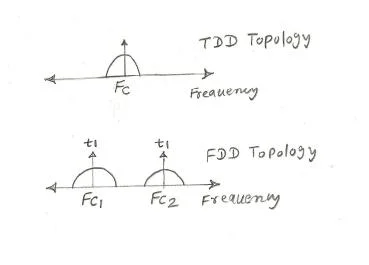Featured post
- Get link
- X
- Other Apps
5G FDD Vs 5G TDD | Difference Between FDD And TDD In 5G
5G FDD Vs 5G TDD | Difference Between FDD And TDD In 5G
compares 5G FDD vs 5G TDD and describes difference between FDD and TDD in 5G wireless network. FDD stands for Frequency Division Duplex and TDD stands for Time Division Duplex.
Introduction:
• Both FDD and TDD are two spectrum usage techniques used in mobile communication networks such as Mobile WiMax, LTE, 5G etc.
• In FDD mode, both uplink and downlink can transmit at the same time at different spectrum frequencies.
• In TDD mode, both uplink and downlink use the same spectrum frequencies but at different times.

• The figure-1 depicts TDD and FDD topologies.
• As shown two different carrier frequencies "Fc1" and "Fc2" are used for uplink and downlink respectively at the same time "t1". Downlink is related to upper part of the spectrum while uplink is related to lower part of the spectrum with guard band (i.e. duplex gap) between these parts.
• Same carrier frequency "Fc" is used at different time instants "t1" and "t2" for uplink and downlink transmission purpose.
In 28 GHz TDD mode, 5G-TF uses frequency range from 27500.5 (Low) to 28349.5 MHz (High) with center frequency of 27925 MHz and bandwidth of 850 MHz. This 5G band is used for both the downlink and uplink chains. Downlink refers to transmission from 5G Base Station (or NB) to 5G UE or mobile phone. Uplink refers to transmission from 5G UE to 5G NB.
5G FDD

The figure-2 describes 5G FDD scenario. As shown same antenna array element is interfaced with diplexer. The device RF diplexer separates transmit and receive frequencies for PA (Power Amplifier) and LNA (Low Noise Amplifier) respectively. As mentioned FDD uses two unique frequencies one for downlink and another for uplink. Hence communication takes place simultaneously in both the directions.
The local oscillator in 5G beamforming module uses frequency in the range from 23.2 to 23.9 GHz. This LO frequency beats with received RF frequency will produce IF frequency at about 4.4 GHz in down conversion. This down converted frequency is provided to LNA module. This LO frequency beats with IF frequency will produce RF frequency at 28 GHz band in up conversion. This up converted frequency is provided to PA module.
5G TDD

The figure-3 describes 5G TDD scenario. As shown same antenna array element is interfaced with SPDT Switch/Filters. It uses only one RF frequency for transmit/receive operations at different time instants. As shown, SPDT (Single Pole Double Throw) switch is used to interface single antenna element with PA/LNA one at a time at same frequency. PA output is filtered before connection with SPDT switch. Similarly received RF signal is filtered before connection with LNA. Both the figure-2 and figure-3 are part of the beamforming module used in 5G mobile phone or 5G smartphone.
Following table summarizes 5G FDD and 5G TDD versions.
| Feature | 5G FDD | 5G TDD |
|---|---|---|
| Application | FDD version is used where both uplink and downlink data rates are symmetrical. | TDD version is used where both uplink and downlink data rates are asymmetrical. |
| Frame structure | FDD frame structure type is used. | TDD frame structure type is used. |
| Interference with neighboring Base Stations | Less | More |
| Deployment type | Not suitable for very dense environments. | It is used in very dense deployments with low-power nodes. |
| Frequency bands | It is preferable for lower frequency bands. | It is preferable for higher frequency bands usually above 10 GHz. |
| Channel response | Downlink and uplink channel responses would not match perfectly due to different frequency bands used in both these directions. | It matches and hence TDD delivers better performance in MIMO/Beamforming algorithms compare to FDD. |
Reference for image-2 and image-3:
Paper on "5G Cellular User Equipment: From Theory to Practical Hardware Design"
Published on July 18,2017 at IEEE Access by YIMING HUO1, XIAODAI DONG1 and WEI XU2
- Get link
- X
- Other Apps
Popular Posts
5G NR MAC Layer-Architecture, Channel Mapping, Procedures
- Get link
- X
- Other Apps
5G NR TBS Calculation | 5G NR Transport Block Size Calculation
- Get link
- X
- Other Apps

Comments
Post a Comment